Christian Boltanski
French, Born 1944
The following are quotes used by Donald Kuspit to introduce his section entitled “Focus” in the Christian Boltanski book, presented in this same order:
“It really seems as though it is necessary for us to destroy some
other thing or person in order not to destroy ourselves, in order to guard
against the impulsion to self- destruction.”–
Sigmund Freud, New Introductory Lectures to Psychoanalysis.
“When you want to kill yourself, you make a portrait of yourself
in the process of committing suicide, but you don’t actually do
it”. – Christian Boltanski, ‘Monument a une personne
inconnue’
“I remember the years just after the war, when anti-Semitism was
still strong in France, ‘feeling… different from the others’.
I fell into such a state of withdrawal that at age eleven I not only had
no friends and felt useless, but I quit school, too”. – Boltanski
“Symbols are needed to overcome the loss of the object which has
been experienced and accepted and to protect the object from one’s
aggressiveness, A symbol is like a precipitate of the mourning for the
object”. – Hanna Segal, Dream, Phantasy and Art.
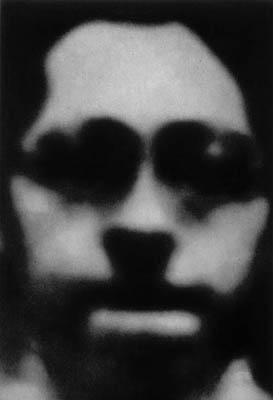
Gymnasium
Chases, 1991
A portfolio of 24 photogravures in a metal box
23-1/4 x 16-1/2
Gymasium Chases, 1991, exhibited prints.
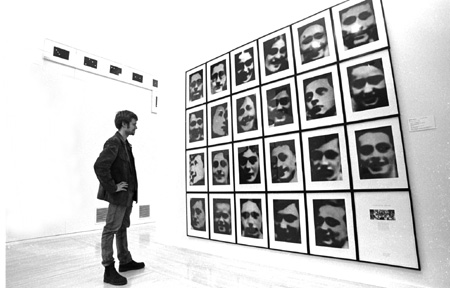
Roland Barthes on posing in front of a camera:
“ I am neither subject nor object but a subject who feels he is becoming an object: I then experience a microversion of death (of parenthesis): I am truly becoming a spectre”.
" The beginning of Boltanski's photographic (identity) quest stems from a psychoanalytic cure when he admitted that he did not remember his childhood. He subsequently attempted to reconstitute his childhood and engaged diverse art forms. Eventually, Boltanski moved from the attempted fictional reconstitution of personal memories to collective memory ". - Sylvie Blum
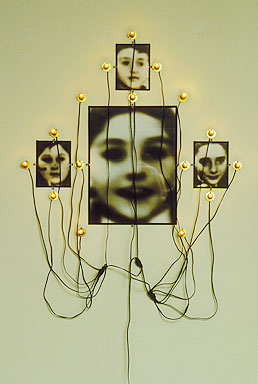
Monument
Odessa, 1991
Mixed media.
Spencer Museum of Art, Univ. of Kansas

Monument
Odessa, 1990
11 photographs, 3 tin biscuit boxes, 68 lightbulbs, glass, and electrical
cords.
High Museum Of Art, Atlanta, Georgia
"I began to work as an artist when I began to be an adult, when I understood that my childhood was finished, and was dead. I think we all have somebody who is dead inside of us. A dead child. I remember the Little Christian that is dead inside me".
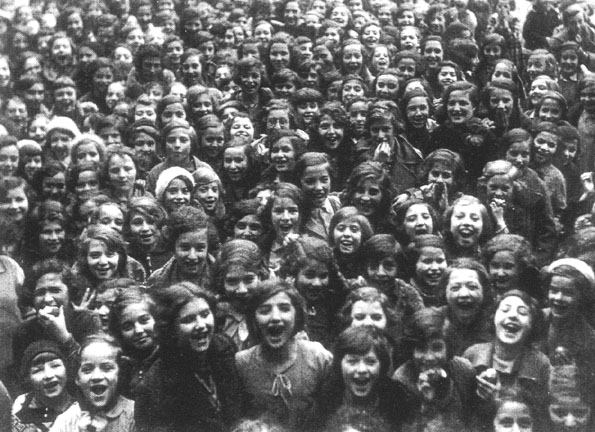
Above
original school photo from 1938
Jewish School of Grosse Hamburgerstrasse, Berlin, 1994
Installation view below
moving photos, lamps, nails, fans
Marian Goodman Gallery, NYC
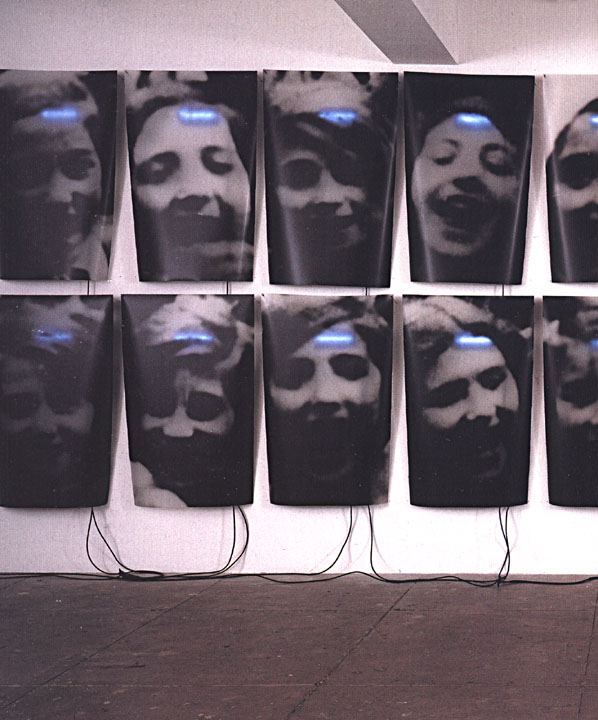
"What drives me as an artist is that I think everyone is unique, yet everyone disappears so quickly. I made a large work called The Reserve of Dead Swiss (1990) and all the people in photographs in the work are dead. We hate to see the dead, yet we love them, we appreciate them. Human. That’s all we can say. Everyone is unique and important. But I like something Napoleon said when he saw many of his dead soldiers on a battlefield: “Oh, no problem – one night of love in Paris and you can replace everybody".
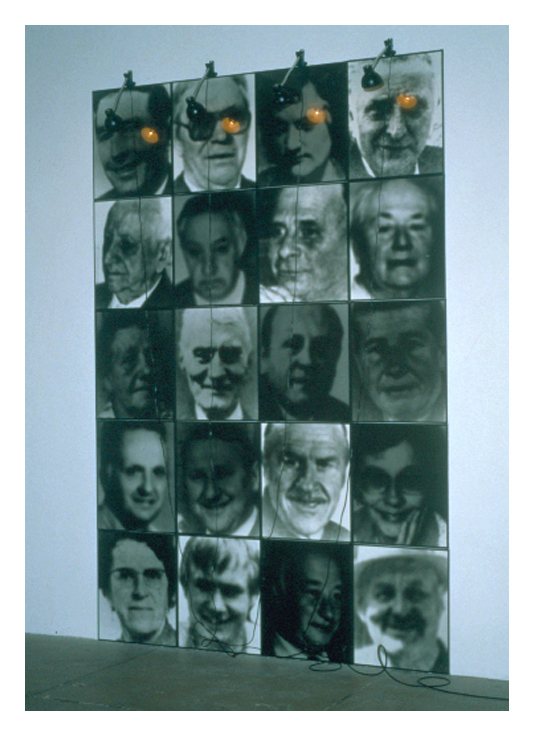
20 Dead Swiss,
1990
photographs, lamps.
Kemper Museum of Cont. Art, Kansas City, Missouri
- “From The “Reference Vitirines” onwards, all of Boltanski’s work operates through accumulation and recycling…. He represents life as a series of successive deaths, a permanent mourning for the self, for the child the child that one has ceased to be and to whom one is forever erecting memorial plaques, but also for the person one ceases to be the moment one begins to talk about him”.
- “Knowing whether an image is true or not, what distance separates
the model from the copy, whether the image is an image of death or life,
these are among the most fundamental questions posed by the artists of
the twentieth century… Boltanski poses them in a way very close
to their original incandescence. In particular, he does this by working
on the permeable boundary between the icon and the idol, between the images
that are venerated and those that are looked at”.
- “In the vocabulary of psychoanalysis, the word phantom is used
for those family secrets whose pain is passed down from generation to
generation without necessarily being made explicit in words”.
Didier Smith, Christian Boltanski, Phaidon 1997.
- “Mourning involves an unconscious fantasy of resurrection as well
as a conscious if reluctant acknowledgment of loss”.
Donald Kuspit, same book.

Autel De Lycee Chases (Altar to Chases High School), 1988
black&white photographs, tin biscuit boxes, lamps
MOCA, Los Angeles
Boltanski
tells that at the beginning of every work of art, there is a historical
or psychoanalytic event, referring to events that have to be told in order
to be better understood:
"I was born at the end of World War II: my 'hidden' father during
the war, the discovery of the Holocaust, my anxiety about my father's
desperation, these are all elements that moulded me ... 'Odessa's Ghosts'
allows me to celebrate my personal stories - we have to entertain the
dead."
http://www.muar.ru/eng/exhibitions/2005/exibit27_01_05_boltansky_e.htm
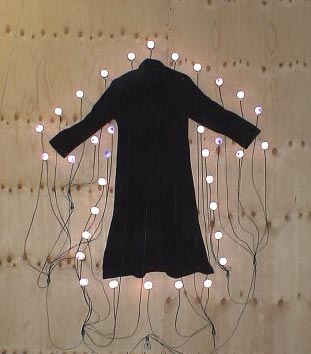
Odessa's
Ghosts, 2005
Installation detail
I Moscow Biennale of Modern Art

Resistence,
1993
cropped photographs from original German mug shots of
captured Reistence fighters.
Installation view Haus der Kunst, Munich

Resistors,
1994
cropped photographs from original German mug shots of
captured Reistence fighters.
Resources:
http://www.artnet.com/artist/2737/christian-boltanski.html
http://www.artcyclopedia.com/artists/boltanski_christian.html
articles:
"Christian Boltanski: representation and the performance of memory"
by Rebecca Caines in Afterimage July/Aug 04:
http://www.findarticles.com/p/articles/mi_m2479/is_1_32/ai_n6181351